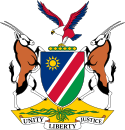Parliament of Namibia | |
|---|---|
 | |
| Type | |
| Type | |
| Houses | National Council National Assembly |
| Leadership | |
Lukas Sinimbo Muha, SWAPO since 15 December 2020 | |
| Structure | |
| Seats | 146 National Council (42) National Assembly (104) |
 | |
National Council political groups | Government (28) SWAPO (28) Official opposition (6) LPM (6) Other parties (8) PDM (2) IPC (2) UDF (2) NUDO (1) Independent (1) |
 | |
National Assembly political groups | Government (59) SWAPO (51) Appointed members (8) Official opposition (20) IPC (20) Other parties (25) AR (7) PDM (5) LPM (5) UDF (1) NEFF (1) SWANU (1) RP (1) NUDO (1) APP (1) NDP (1) BCP (1) |
| Elections | |
National Council voting system | Indirect election by regional councils |
National Assembly voting system | Closed list proportional representation and appointments by the President |
Last National Council election | 25 November 2020 |
Last National Assembly election | 27 November 2019 |
| Meeting place | |
 | |
| Tintenpalast, Windhoek, Khomas Region, Namibia | |
| Website | |
| www | |
 |
|---|
The Parliament of Namibia is the national legislature of Namibia. It is a bicameral legislature and, thus, consists of two houses:[1][2] the National Council (upper house) and the National Assembly (lower house).
All cabinet members are also members of the lower house. This situation has been criticised by Namibia's civil society and the opposition as creating a significant overlap between executive and legislature, undermining the separation of powers. The seniority of cabinet members generally relegate ordinary MPs to the back benches.[3]
From Namibian independence until 2014 the National Assembly consisted of 78 members, 72 members elected by proportional representation and 6 members appointed by the president. The National Council had 26 representatives of the Regional Councils, 2 from each of the then thirteen regions.[1] Prior to the 2014 general elections the constitution was amended to increase both chambers to their current size.[2]
Speakers of Parliament
[edit]- Hon. Prof. Peter Katjavivi, MP - Speaker of the National Assembly
- Hon. Prof. Loide Kasingo, MP - Deputy Speaker of the National Assembly
See also
[edit]References
[edit]- ^ a b "GRN Structure. The Legislature". Government of Namibia. Archived from the original on 18 August 2011. Retrieved 29 September 2011.
- ^ a b Quadri, Maryam Omolara; Thomas, Erika K (2018). "Women and political participation in Namibia and Nigeria: a comparative analysis of women in elective positions" (PDF). Journal for Studies in Humanities and Social Sciences. 7 (2). University of Namibia: 6–9. ISSN 2026-7215.
- ^ Sasman, Catherine (22 March 2013). "Mbumba's presence in Cabinet under spotlight". The Namibian. Archived from the original on 13 April 2013.
External links
[edit]
